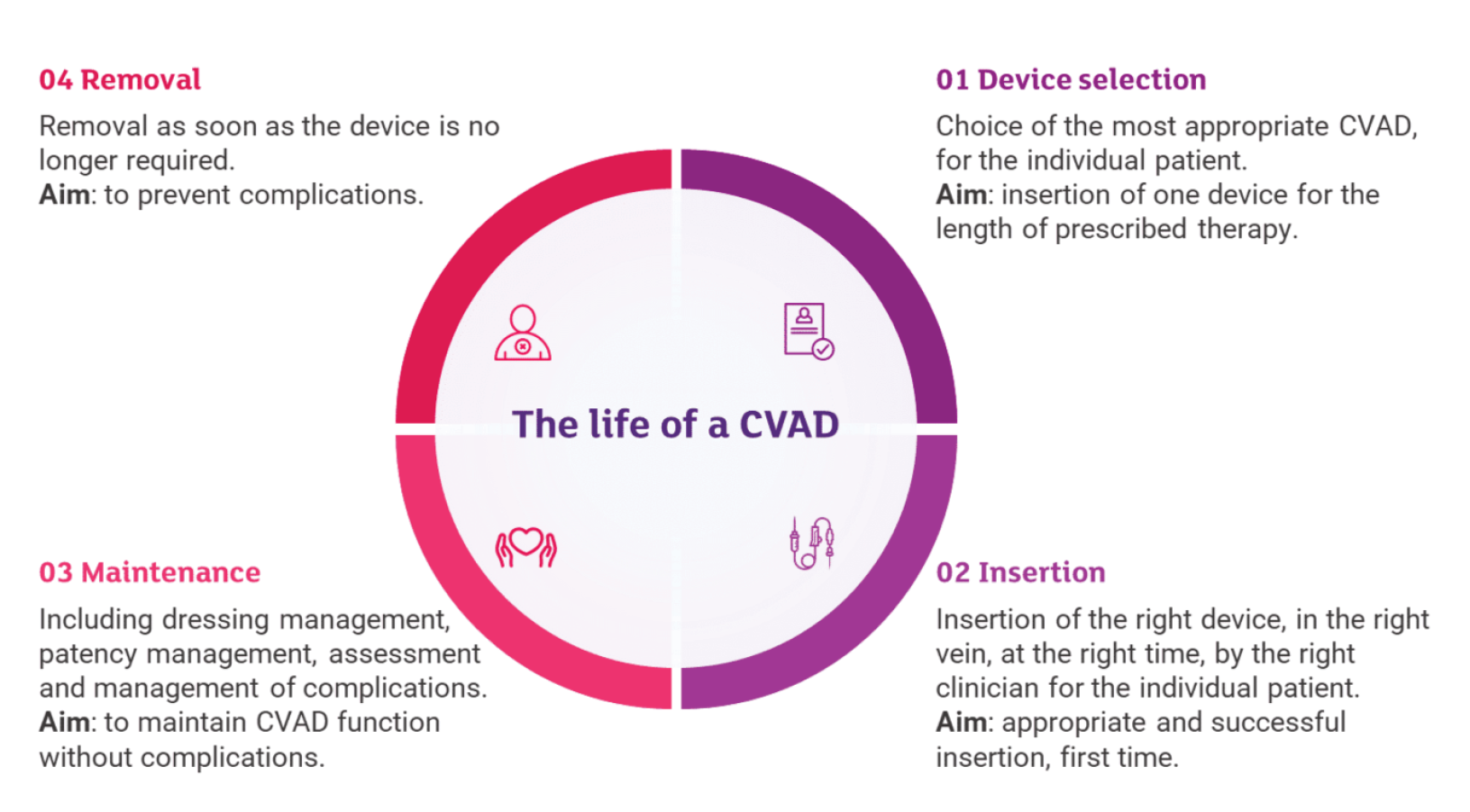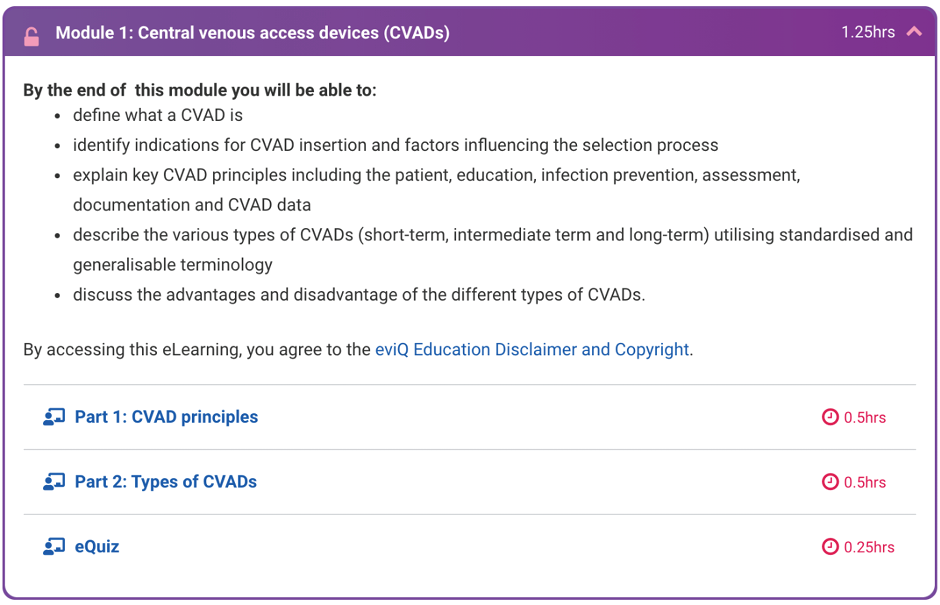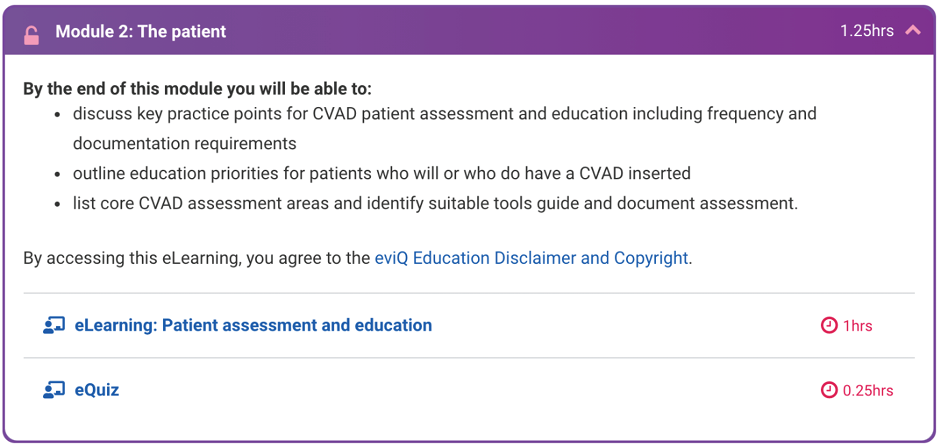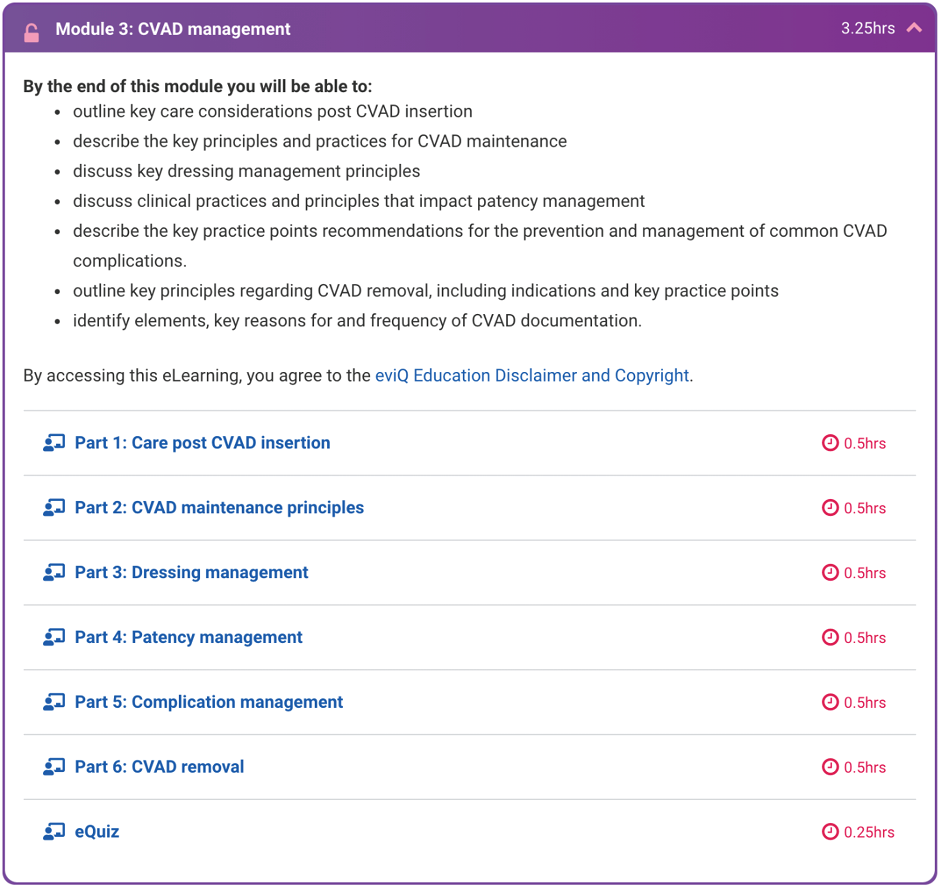Volume 7 Issue 2
New eviQ central venous access device education and resources available
Kerrie Curtis and Gillian Ray-Barruel
Keywords education, Central venous catheters, evidence-based practice, vascular access devices, peripherally inserted central catheters, online learning
For referencing Curtis K and Ray-Barruel G. A New eviQ central venous access device education and resources available. Vascular Access 2021; 7(2):7-11.
DOI https://doi.org/10.33235/va.7.2.7-11
Abstract
Central venous access devices (CVADs) are a mainstay for many patients receiving mid-to-long-term intravenous therapy. Cancer Institute of NSW programs, eviQ and eviQ Education, provide free online cancer treatment protocols and resources for clinicians, patients and carers. In 2021, the complete suite of eviQ CVAD resources were updated via extensive consultation with vascular access experts and the evidence-based literature to reflect the latest evidence for CVAD management. Resources include eLearning modules, clinical procedures, complication management algorithms, assessment and documentation tools, quizzes, and patient education materials. We encourage readers to explore and promote eviQ and eviQ Education for CVADs and share these resources with nursing, interventional radiology, or medical colleagues caring for patients with a CVAD, as well as patients and carers.
The importance of CVAD education
Central venous access devices (CVADs) are critical for efficient, reliable delivery of prescribed medical therapies. In particular, CVADs are a vital resource for intensive care patients and patients with cancer or other conditions requiring frequent or prolonged periods of supportive and systemic therapies.1 Used in all patient age groups, from neonates to the elderly, CVADs can remain in place for hours or up to several years, and are managed in diverse healthcare settings, from acute inpatient and ambulatory units to the community and the home. A functioning CVAD is a patient’s lifeline, but these devices come with many risks, and, as such, it is essential that anyone involved in CVAD insertion and management understands how to eliminate harm wherever possible.
An unacceptably high number (15–66%) of CVADs fail prematurely in all patient populations,2 which can result in patient harm, delayed treatment, increased morbidity and mortality, and increased healthcare expenditure.3 The pathophysiology of cancer and complications of prescribed infusion therapies further increases the risk of CVAD complications and failure, including life-threatening bloodstream infection,4 bleeding, thrombotic complications,5 as well as skin impairment and delayed healing of CVAD wounds,6 such as totally implantable venous access device suture lines or catheter exit sites.
Informed and competent CVAD maintenance, surveillance, early detection, and expert management of complications is key to minimise impact on the patient and healthcare service.7 CVAD management is complex and incorporates repeated clinical maintenance procedures influenced by patient, clinical, therapy, and individual healthcare service factors. A plethora of multidisciplinary professionals, patients, and carers are potentially involved with CVAD care. Therefore, education and competency are a standard of practice for CVAD management and critical to reducing the risk of premature failure and removal.7
Available resources
The Cancer Institute of NSW programs, eviQ and eviQ Education, are free, accessible, national online linked platforms for cancer treatment protocols. They also provide resources including clinical procedures, algorithms, assessment and documentation tools, education modules, and quizzes, for multidisciplinary clinicians, as well as information for patients and carers. The eviQ CVAD resources were updated in 2021; the entire review process was coordinated and managed by an expert facilitator skilled in project management from eviQ Education. A subject matter expert in cancer and vascular access conducted extensive topic reviews to ensure the best available evidence could be incorporated into the resources. A Delphi-type review method was implemented to review the content of the resources, with numerous internal reviews by experts within eviQ and eviQ Education, followed by an external round of peer review with twenty-four adult and paediatric cancer nurses practising nationally, and continuing internal reviews until consensus was achieved.8 Content for Aseptic Non-Touch Technique (ANTT®) was reviewed and supported by the Association for Safe Aseptic Practice (ASAP). Finally, the resources were reviewed and endorsed by the Cancer Nurses Society of Australia (CNSA) and the Australian Vascular Access Society (AVAS), and supported by the Alliance for Vascular Access Teaching and Research (AVATAR), ASAP, and Intravenous Nurses New Zealand (IVNNZ).
The eviQ CVAD management course was designed to support nursing, medical and other multidisciplinary healthcare professionals caring for patients who have had, or will have, a CVAD inserted. Every clinician caring for a patient with a CVAD, whether they are involved with direct patient care for insertion or maintenance, hospital quality and safety, infection prevention, or community services, would benefit from completing this free online course.
The course is delivered via an online platform and includes three modules incorporating learning objectives, didactic content, supported throughout with clinical images and diagrams, interactive activities, recall questions, and a quiz at the completion of each module. Expected timeframes for completion are included in each module.
Each module is structured around the Vessel Health and Preservation four quadrants of care9 in the life of a CVAD – device selection, insertion, maintenance, and removal (Figure 1). With vessel health and preservation now a priority consideration for every clinician, the device selection component instructs learners in the process for deciding which is the right device for the individual patient’s needs.

Figure 1. The life of a CVAD
Module One begins by presenting the different types of CVAD and principles of selection. The different types of CVADs, features, advantages, and disadvantages are discussed using generic terminology to facilitate translation across different settings and workplaces. Once the choice of device has been confirmed, the insertion component steps clinicians through important considerations and evidence to achieve successful insertion, first time, every time. Core principles that guide CVAD management and removal are detailed, including the patient and family, infection prevention, dressing and patency management, assessment and documentation, and finally complication assessment and management (Figure 2).

Figure 2. Module 1: CVADs
Module Two focuses on the patient and family, key participants in the healthcare team for device selection, care, maintenance, and, finally, removal of a CVAD. Education and assessment throughout the life of a CVAD is discussed via a case study – a gentleman requiring vascular access for ongoing chemotherapy for colorectal cancer (Figure 3).

Figure 3. Module 2: The patient
Module Three is a comprehensive module, divided into six parts: (1) core principles applicable during the maintenance phase of a CVAD, including an infection prevention maintenance bundle; (2) patient and CVAD dressing and potential complication management immediately post-insertion; (3) the latest evidence for dressing and securement; (4) core patency practices to maintain device function; (5) assessment and management of common complications; and (6) removal, which teaches clinicians how to make a timely decision on when to remove the CVAD and provides instruction on how to remove the CVAD safely to minimise the possibility of adverse outcomes, including haemorrhage, air embolus, and retained catheter (Figure 4).

Figure 4. Module 3: CVAD management
This course links with key resources on the eviQ website to provide practical support and guidance for clinical practice. These resources include seven clinical procedures, assessment and documentation tools, and algorithms for assessment and management of two common complications – skin impairment and occlusion. Many patients who require a CVAD return home with their device, so the eviQ Education website also provides free CVAD resources for patients and carers.
Conclusion
This unique suite of evidence-based, standardised resources using generic terminology facilitates the translation and application of evidence into practice, from device selection through to removal, in critical care, acute, ambulatory, and homecare settings. We encourage readers to access, explore, and share eviQ and eviQ Education for clinician and patient CVAD education. To learn more, please visit the Cancer Institute NSW eviQ and eviQ Education websites.10,11
Declarations/conflict of interest
KC has been employed as the Subject Matter Expert by Cancer Institute NSW to research and prepare the eviQ and eviQ Education suite of resources. KC reports consultancy payments provided to AVATAR, Griffith University by product manufacturers (3M, ICU Medical, Baxter), unrelated to this project.
GRB reports consultancy payments provided to Griffith University by product manufacturers (3M, Becton Dickinson) and education providers (Ausmed, Wolters Kluwer), unrelated to this project.
Author(s)
Kerrie Curtis1,2* and Gillian Ray-Barruel2,3
1 eviQ, Cancer Institute of New South Wales, NSW, Australia
2 Alliance for Vascular Access Teaching and Research, Menzies Health Institute Queensland and School of Nursing and Midwifery,
Griffith University, Nathan, QLD, Australia
3 QEII Jubilee Hospital, Coopers Plains, QLD, Australia
*Corresponding author
Kerrie Curtis, Email kerrie.curtis@petermac.org
References
- Boll B, Schalk E, Buchheidt D, Hasenkamp J, Kiehl M, Kiderlen TR, et al. Central venous catheter-related infections in hematology and oncology: 2020 updated guidelines on diagnosis, management, and prevention by the Infectious Diseases Working Party (AGIHO) of the German Society of Hematology and Medical Oncology (DGHO). Ann Hematol. 2021;100:239–59.
- Keogh S, Flynn J, Marsh N, Higgins N, Davies K, Rickard CM. Nursing and midwifery practice for maintenance of vascular access device patency: a cross-sectional survey. Int J Nurs Stud. 2015;52:1678–85.
- Takashima M, Schults J, Mihala G, Corley A, Ullman A. Complication and failures of central vascular access device in adult critical care settings. Crit Care Med. 2018;46:1998–2009.
- Conley SB. Central line-associated bloodstream infection prevention: standardizing practice focused on evidence-based guidelines. Clin J Oncol Nurs. 2016;20:23–6.
- Levi M, Sivapalaratnam S. An overview of thrombotic complications of old and new anticancer drugs. Thromb Res. 2020;191 Suppl1:S17-s21.
- Broadhurst D, Moureau N, Ullman AJ, World Congress of Vascular Access (WoCoVA) Skin Impairment Management Advisory Panel. Management of central venous access device-associated skin impairment: an evidence-based algorithm. J Wound Ostomy Continence Nurs. 2017;44(3):211–20.
- Gorski L, Hadaway L, Hagle M, Broadhurst D, Clare S, Kleidon T, et al. Infusion therapy standards of practice. J Infus Nurs. 2021; 44.
- Hasson F, Keeney S, McKenna H. Research guidelines for the Delphi survey technique. J Adv Nurs. 2000;32:1008–15.
- Moureau NL. The VHP model. In: Moureau N, editor. Vessel health and preservation: the right approach for vascular access [Internet]. Springer; 2019. Available from: https://doi.org/10.1007/978-3-030-03149-7_1
- Cancer Institute NSW. Cancer Institute NSW eviQ resources; 2021 [cited 2021 Sep 13]. Available from: https://www.eviq.org.au/clinical-resources/central-venous-access-devices-cvads
- Cancer Institute NSW. Cancer Institute NSW eviQ Education; 2021 [cited 2021 Sep 13]. Available from: https://education.eviq.org.au/courses/clinical-and-community-practice/central-venous-access-devices
Author notes
Kerrie Curtis, RN, MN Cancer/Palliative Care
PhD Candidate, Vascular Access and Cancer Care
Chair, Vascular Access Device and Infusion Therapy Specialist Practice Network
Victorian Chapter Lead, AVATAR
Victorian Representative, AVAS
Adjunct Research Fellow, Menzies Health Institute Queensland, Griffith University
Gillian Ray-Barruel, RN, PhD, MACN
Senior Research Fellow, Conjoint Griffith University and QEII Jubilee Hospital
Education Director, AVATAR
Endeavour Leadership Award Fellow
